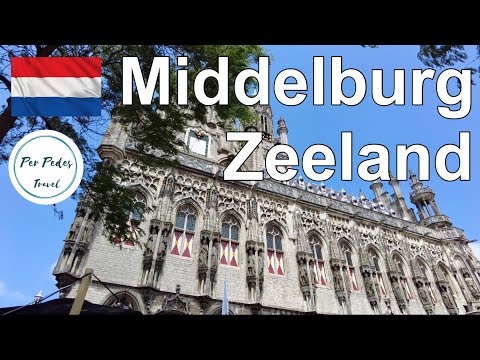Middelburg, Zeeland, Netherlands Walking Tour (with Subtitles) - July 2021

Thank you for joining us for our walk around the Dutch city of Middelburg. Middelburg is in the capital of the province of Zeeland. It has a population of about 48,000. Middelburg used to be one of the most important cities in the country, and still today Middelburg is packed with monuments reminding of those golden times. A good part of the centre is still surrounded by the old, star shaped canal ring.
The centre is dominated by a large square, still regularly used as a market square and overlooked by the beautifully ornamented former town hall. Around the central area, you'll find a mostly pedestrianised shopping area. The Town Hall is one of the finest gothic buildings in the Netherlands. Construction began in 1452 and it was completed only in 1520.
The gothic facade boasts 25 statues of Zeeland's counts and countesses. The statues of the counts and countesses were once painted in bright colors. The series of statues starts at the left with Dirk the fifth of Holland and Zeeland, he ruled from 1061-1091. The series ends with emperor Karel the fifth (1596-1555). The last one, Filips the second (1555-1598) is not included, even though a podest in reserved for him. This is most likely due to the war between him and the Netherlands. We visited on a Thursday, during the weekly market (from 8:30am to 4pm). There are many varieties of cheese in the Netherlands. The best known Dutch cheeses are perhaps Gouda and Edam.
However there are many other varieties such as Beemster, Graskaas, Leerdammer, Leyden, Limburger, Maaslander, Maasdam, Mimolette, Nagelkaas, Parrano, Roomano, Prima Donna and Vlaskaas. Hundreds of Middelburgs monuments were damaged or completely destroyed in WWII. However, in the decades that followed, the city worked hard to rebuild its centre and restore the cultural heritage that remains. Today over 1100 national monuments make Middelburg a top ten Dutch heritage site.
There's a clearly historic feel to the old town, which is encircled by a pretty pattern of canals, once part of the 1595 fortifications. To see the best of town, stroll along the canals and through the old streets around the charming Market Square. The double-naved Nieuwe Kerk (New Church) was part of a 13th-century Abbey but largely rebuilt in the 16th century after a fire extensively damaged the complex.
A prominent feature of the town's profile is the abbey church tower known as "Lange Jan" ("Tall John") on the southside of the Choir church. The lower part of the tower dates from the fourteenth century. The eastern wall of the New church is also the western wall of the Choir church, and the two interiors were originally connected through an arch, but this was subsequently blocked up. The designation "New church" was used to differentiate this building from Middleburg's "Old church", also sometimes called the West or North Minster church, but the old church was torn down in 1833. A flea market takes place from mid-June to late August every Thursday. In terms of technology, Middelburg played a role in the Scientific Revolution at the early modern period.
The town was historically a center of lens crafting in the Golden Age of Dutch science and technology. The invention of the microscope and telescope is often credited to Middelburg spectacle-makers (including Zacharias Janssen and Hans Lippershey) in the late 16th century and early 17th century. Monument of Queen Mother Emma (1858-1834) who served as regent for her daughter, Queen Wilhelmina, during the latter's minority from 1890 until 1898.
Memorial stone for Wouter Weylandt (1984-2011), a Belgian cyclist who died in a crash in the 2011 Giro d’Italia. Lavish 17th and 18th century merchant houses and storehouses stand along canals, of a similar style as found in cities like Amsterdam. in the 17th century (the Dutch Golden Age), Middelburg became, after Holland's metropolis Amsterdam, the most important center for the Dutch East India Company (VOC) in the Republic of the Seven United Netherlands. As such, Middelburg also played an important role in the 17th century slave trade. Stolperstein in honor of Marcus Nathan, a Jewish resident who was murdered in Auschwitz in 1943. Stolpersteine are concrete cubes bearing a brass plate inscribed with the name and life dates of victims of Nazi extermination or persecution.
Stolpersteine are placed in front of the victims last residence. By December 2019, a total of 75,000 stones had been placed in many European countries. One well-known citizen of Middelburg was the admiral and explorer Jacob Roggeveen, who was born in the city in 1659 and died there in 1729. Roggeveen discovered Easter Island (Rapa Nui) on Easter Sunday, April 6, 1722, as well as later the islands of Bora-Bora and Samoa. Thank you for having joined us on our tour of Middelburg.
If you liked it, please subscribe to our channel.
2021-07-18 20:23


